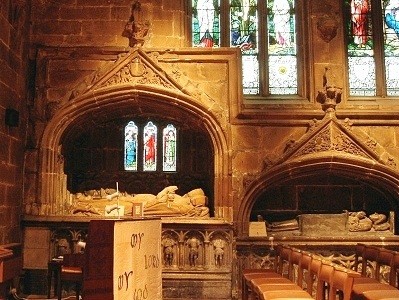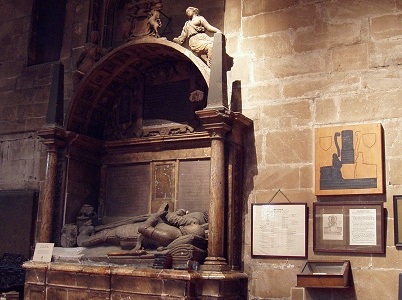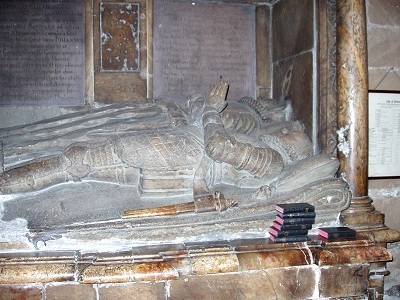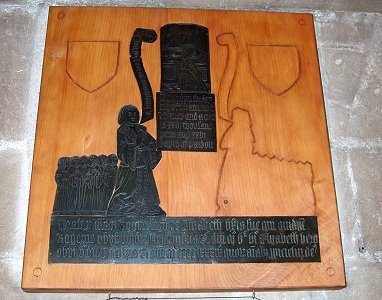MACCLESFIELD No. 7
St. Michael's: The Savage Chapel and
Savage Family
Grid Ref: SJ 918 737
24 January 2003
 |
|
 |
John Savage the 7th, with his wife, Elizabeth, daughter
of
the Earl of Worcester. He died in 1528. |
|
John & Elizabeth Savage: detail of the heads and hands |
 |
|
 |
Effigy of a civilian, possibly William Legh, in which
the
central section has not been completed |
|
View across the chapel towards the two effigies, taken
by natural light with a long exposure. |
 |
|
 |
Right of the effigies is a chart of the ministers,
the Legh Pardon Brass, and the Breeches Bible |
|
The tomb of John Savage and Elizabeth Manners |
 |
|
 |
The Legh Pardon Brass. Roger Legh died 4 November
1506 and his wife Elizabeth died on 5 October 1489. |
|
Canopy of the tomb of John Savage with inscription in
Latin and the date of 1597 |
There was a chapel in
Macclesfield from 1220 which was enlarged in 1278, with support from Eleanor of
Castile the wife of Edward I. They were betrothed when he was
13 and she 12 and had 16 children. The Savage
Chapel and Legh Chapels of the South Aisle date from 15th and 16th centuries.
The medieval chapel was replaced by a Georgian Church between 1739 and 1740 and this in turn was
extensively altered at the end of the 19th century to give what appears to be an
essentially Victorian structure. The pulpit survives from the Georgian
church but the organ was moved to St. Albans R.C church in Macclesfield.
The orginal tower is incorporated inside the present one. In
the foyer of the church, just to the right of the door, there are remains of a
limestone arch.
The Savage Chapel was built by Thomas Savage between 1502 and 1507. It was
built as a chantry chapel. Thomas Savage became Archbishop of York and in this capacity
was responsible for the marriage ceremony of Prince Arthur, eldest son of Henry
VII, to Catherine of Aragon. Arthur died young and his brother Henry, who became
Henry VIII, then married Catherine. The chapel is reached from the south aisle.
The three storey porch has the shields of Rocester, London and York - the three
places where Thomas Savage was a bishop before becoming an Archbishop. Note
in the picture top left the small dog tugging at the folds of the dress of John
Savage's wife. The tomb with the canopy at the bottom right and the effigies
in the picture above it belong to John Savage who built Rock Savage near Runcorn,
a house on which Brereton Hall was modelled. Elizabeth
Manners, daughter of the Earl of Rutland, lies higher than her husband because
of her more noble birth.
The Legh Chapel was built in 1422 for the burial of Piers Legh of Lyme. He
fought at Agincourt in 1415 and died at the seige of Meaux. He and his father
are commemorated by a brass plaque on the wall of the chapel, but it is difficult
to photograph.
The East Window in the Savage Chapel was bought in memory of Francis Brocklehurst and created from the pattern book of Burne Jones. Among the figures depicted are St. Chad and Eleanor of Castille. Francis Brocklehurst was a banker from the silk weaving family; his bank was in King Edward Street near the Unitarian Chapel. Francis Brocklehurst paid for the East Window in the Nave and the West Window in memory of Queen Victoria. He gave Victoria Park to the town.
The Legh Pardon Brass and
a Summary of Changes during the Reformation
The Legh Pardon Brass was made in 1506 to commemorate Roger Leigh and his wife.
It is a survival from the period before the Reformation. It refers to the practice
of buying indulgences. The idea of purgatory was created by Pope Gregory and
the Council of Lyon in 1274. It was said to be a place where the soul awaited
judgement. People hoped to reduce the length of time their souls spent in purgatory
by endowing chantry chapels where priests would pray for them, or by buying
indulgences. In 1505, Pope Julius II rebuilt St. Peter's by selling indulgences.
The brass used to show Roger Legh, his wife Elizabeth, six sons and seven daughters.
This is known from a drawing made by Randal Holmes, the Cheshire Historian,
in 1660 but the right side of the brass has been lost. The pardon granted for
saying five Paternosters, five Aves and a creed was 26 thousand years and 26
days. It is not related how much money changed hands or indeed how the authorities
calculated the amount of pardon that corresponded to various prayers or payments.
This practice was seen as one of the more corrupt elements of the church at
the time of the Reformation. Martin Luther was a vehement opponent.
Although the Church of England broke away from the control of the Pope during
the reign of Henry VIII, in terms of doctrine and practice it remained essentially
the same. The real Reformation took place under Henry's son, King Edward VI,
who reigned from 1547 to 1553. He was strongly influenced by Archbishop Cranmer,
a proponent of reform. On 25 December 1547, Edward ordered the confiscation
of the money and land bequeathed to support chantry chapels. Chantry priests
were pensioned. In the same year Edward ordered that candlesticks, paintings,
statues and holy water stoops should be removed from churches. The bones of
saints, that were formerly held in reliquaries, had to be buried and stained
glass was destroyed in many churches. The use of incense, worship of saints
and statues, and prayers for the dead were abolished. In 1552, it was stated
that purgatory did not exist. It was during this reign, in 1547, that churches
were first required to have pulpits. The view of the King, expressed through
the archbishop and bishops could be passed to the priests for communication
to the populace. It was the introduction of the sermon that then led, in subsequent
years, to the installation of pews. Before this the congregation stood in the
nave except for a few, who could sit on a stone bench around the edge - hence
the expression "the weakest to the wall". Hitherto the priest had
remained in the chancel speaking only Latin while the largely illiterate congregation
stood in the nave. With the introduction of the new prayer book and the translation
of the bible into English, the congregation were in a position to follow what
took place. Services were brought into the nave with the use of a reading desk
for the priest. Cranmer's book of Common Prayer was introduced on 7 March 1549
with a revised version in 1552.
The doctrinal changes were reversed when Edward VI was succeeded by his half
sister, Queen Mary (1553-1558) who was a Catholic. By this stage, many of the
artefacts associated with the old religion had been lost. When Elizabeth I succeeded
Mary, the country swung back to Protestantism. She reintroduced the Prayer Book
of 1552 and confirmed Edward's reforms by issuing the "Thirty Nine Articles"
in 1563. Rood lofts were small platforms above the rood screen. They were demolished
by Puritan factions but Elizabeth allowed them to be moved to form West Galleries
used by musicians. Hence the expression "turn to face the music".
During the Civil War, the Puritans were responsible for destroying what they
saw as remaining items associated with Catholicism and during this period Cheshire
lost most of what remained of its Norman fonts. In the 19th century, a number
of the old practices were reintroduced by the supporters of the Gothic Revival
in the Church of England. For example, a 19th century rood loft can be seen
at Manchester Cathedral. Stained glass and candles are seen in most Anglican
churches as illustrated on this web site but statues with candles burning in
front of them and pictures are seen in only a few "High Church" establishments;
they are uncommon in Cheshire.
The Savage Family
The Savage family tree is complicated by the fact that no less than nine in
succession were called John. The following is taken from Ormerod's History of
Cheshire, which draws on Sir Peter Leycesters work for the pedigree prior to
about 1673. For the most part I concentrate in each generation on the heir but
notes are included on their siblings where there is some historic interest or
a connection with other Cheshire families mentioned on this site.
The tree starts with the first John Savage, who married Margaret Daniers or
Daniell. She was daughter and heir of Sir Thomas Daniers of Bradley in Appleton,
commonly called Daniel. Her mother's name was Isabel, daughter and heir of William
Baggiley by Clemence his wife, daughter and coheir of Sir Roger Dutton of Chedhill
in Cheshire, commonly styled Sir Roger de Chedhill, lord of Chedill and Clifton.
This Margaret Daniell had all her mother's lands but her father's lands were
settled on the male heirs of the Daniels, initially her father's younger brother John.
- 1. John Savage, died 10 Rich II. 1386
- + Margaret Daniers or Danyers, d. of Sir Sir Thomas Daniers. She had three husbands,
the first was John Ratcliffe 42 Edw III who died without issue by her. The
second husband was John Savage, married about 49 Edw III. After John Savage's
death, she then married Piers Legh of Macclesfield (younger son of Robert
Legh of Adlington) by whom she had issue Piers Legh, from whom the Leghs of
Lyme in Macclesfield Hundred; and John Legh, younger son, escheator of Cheshire
12-13 Hen VI from whom the Leghs of Ridge nigh Macclesfield. Margaret survived
all her husbands and died in 1427. In addition to her son with John Savage,
she had two daughters by him, Elizabeth and Blanche.
- 2. John Savage, of Clifton, knight, 6 Hen V. had the mannor of Barrow
from his wife Maude. They were married prior to 1409. After the death
of Maude, Sir John married Elena, widow of James Haryngton, in 1428. This
Sir John Savage was referred to as a knight in 4 Hen V. and was probably
knighted at Agincourt in 3 Hen V. He died 1 August, 28 Hen VI (1449)
- + Maude, daughter and heir of Sir Robert Swinnerton. In addtion to their
son John they had William; Arnold, who married Elen daughter of William,
son and heir of Richard de la Lee, juxta Bacford, knight, circa 1458;
George and Roger. Also two daughters: Margaret, married John Dutton, second
son of Sir Piers Dutton of Dutton, 6 Hen V, afterwards heir to Sir Piers
his father; and Maude married Sir Thomas Booth of Barton in Lancashire.
- 3. John Savage,of Clifton, Esq.
- + Wife not named in Ormerod. In addition to their son John there
were also two daughters: Margery, who married Edmund Legh of Baggiley
in Cheshire, Esq. about 15 Edw. IV. She afterwards married Thomas
Leycester, of Nether Tabley, Esq, 17 Edw.
IV. 1477 (and was his second wife). Margaret, another daughter, married
John Maxfield, afterwards she married Randle Mainwaring
of Carincham (commonly now called Kermincham) third son of Randle
Mainwaring of Over-Pever, Esq.
- 4. Sir John Savage,of Clifton, senior, knight 17 Edw. IV. 1477.
He died 22 November 1495 aged 73.
- +Catharine, daughter of Sir Thomas Stanley, after Lord Stanley
and sister to Thomas Stanley Earl of Derby. In addtion to their
eldest son John this couple also had: Thomas Savage, bishop of
Rochester 1492, then London 1497, then archbishop of York 1501
and died 1508, his body being buried at York and his heart at
Macclesfield in Cheshire, where he built a chappel at the side
of the church and intended to have a college there: Sir Homphrey
Savage: Lawrence Savage; James Savage; Sir Edmund Savage, knighted
at Leith in Scotland, 11 May 1544, which Edmund married Mary,
the widow of Roger Legh del Ridge near Macclesfield and daughter
and heir of William Sparke of Surrey, 30 Hen VIII, 1538; Christopher
Savage; William Savage; George Savage; and Richard Savage: also
Ellen Savage, a daughter, married Peter Legh of Lyme in Cheshire,
1467. Katherine, another daughter married Thomas Legh of Adlington
in Cheshire, Esq., in 1479. Margaret married Edmund Trafford
of Trafford in Lancashire. Alice married Roger de Pilkington of
Lancashire and Elizabeth married John, son of William Leeke of
Langford in Derbyshire.
- 5. Sir John Savage of Clifton, junior, knight, had the charge
of the left wing at the Battle of Bosworth Field in Leicestershire,
22 August 1485. He was very instrumental, together with Thomas
Lord Stanley, his uncle, afterwards made Earl of Darby, in
the promoting of Henry VII to the crown and in obtaining the
victory at Bosworth; for which service Henry VII granted him
several manors in Leicestershire, Derbyshire, Nottinghamshire
and Shropshire. Sir John was killed at the siege of Bolougne
8 in 1492 in the lifetime of his father. He was made knight
of the garter by Henry VII. He had a bastard son, called George
Savage, parson of Davenham in Cheshire.
- + Wife unknown in Ormerod. Children in addition to John
were: Alice, married Sir William Brereton
of Brereton in Cheshire; Felicia, married Robert Milward of
Eaton in Derbyshire, Esq; Ellen, married John Hawarden; Maude,
married Sir Robert Needham of Shenton in Shropshire.
- 6. Sir John Savage of Clifton, was knighted about 13
Hen VII and was sheriff of Worcestershire 24 years from
the death of his father. He was styled Sir John Savage
the elder, 12 Hen VIII. He died 2 March 1527
- + Anne, daughter and heir of Raufe Bostock of Bostock
in Davenham parish, Esq., In addition to John Savage,
had Edward, George, Richard, Lawrence, Roger and Thomas
and also a daugher Anne.
- 7. Sir John Savage of Clifton, knight, styled the
younger in 1520; he died 27 July 1528 aged 35, when
his heir, John was only three years nine months old.
- + Elizabeth, daughter of Charles Somerset, Earl
of Worcester. Issue John Savage, son and heir; Henry;
Margaret, married Sir Richard Buckley of Beaumorris
in Wales; Mary, married John Hamden of Hamden. When
widowed from Sir John, Elizabeth married Sir William
Brereton of the bedchamber to Hen VIII, beheaded for
alleged dalliance with Queen Anne, 17 May 1536. He
was the younger son of Sir Randle Brereton of Malpas.
- 8.Sir John Savage of Clifton, knight. Married
first Elizabeth Manners and after her death Elinour,
widow of Sir Richard Pexhull of Beaurepair in
Southamptonshire and daughter of John Cotgreve
but had no children by her. This Elinour had extensive
land from the will of Sir Richard Pexhull which
Sir John settled on his younger son, Edward. Sir
John Savage of Clifton built the new house at
Clifton, 1565 which was afterwards called Rock
Savage. He was sheriff of Cheshire seven times
and three times mayor of Chester. He died 5 December
1597 aged 73 and was buried at Macclesfield the
24 January 1597 (Julian Calendar had new year
start on 25 March)
- + Elizabeth, daughter of Thomas Mannours, Earl
of Rutland, about 1 Edw. VI. 1547 by whom he had
five sons and five daughters. John born 1548 died
an infant; another John born 1554 succeeded as
heir, Thomas, born 1556 died young; Edward, born
1560; Francis, born 1562 and died young. Margaret,
born 1549 married Sir William Brereton
of Brereton in Cheshire, afterwards Baron of Laghlin
in Ireland, who built the fine new house at Brereton.
Second daughter was Elizabeth, born 1552, married
Thomas Langton, baron of Newton in Lancashire,
1580. Elinour, third daughter, born 1557, married
Sir Henry Bagnall, son and heir of Sir Nicholas
Bagnall, knight, marshal of the Queen's army in
Ireland, 1577. Later she married Sir Sackvill
Trever. Mary, fourth daughter, born 1563, married
Sir Richard Milles in Hampshire. Frances, fifth
daughter, born 1567 married Thomas Wilkes, Esq.,
of Surrey. Sir John's wife Elizabeth, died 8 August
1570.
- 9. Sir John Savage of Rock Savage, created
baronet in 1611. Sir John was mayor of Chester
1607 and sheriff of Cheshire the same year.
He was buried at Macclesfield Friday 14 July
1615
- +Mary, one of the daughters and coheirs
of Richard Allington, Esq., deceased about
1575 and had issue John, who died young; Thomas
Savage, second son, who succeeded; John Savage,
third son; Richard Savage; William Savage.
Also a daughter Elizabeth, who married Thomas
Manwaring younger son of Manwaring of Martin-Sands
near Over in Cheshire and had issue: afterwards
she married Sir Raufe Done of Duddon in Cheshire.
Grace Savage, another daughter married Sir
Richard Wilbraham of Woodhey in Cheshire.
- 10. Sir Thomas Savage of Rock Savage,
baronet, was created Viscount Savage by
Charles I on 6 November 1626. Jane, sister
and heir to Sir William Cordell, master
of the rolls, and lord of Long-Melford
in Suffolk, gave by her will to Sir Thomas
Savage, Long-Melford with other lands
in Suffolk, dated 15 July 1602. She was
widow of Sir Richard Allington and grandmother
to Sir Thomas Savage. Thomas Viscount
Savage was chancellor of the Queen's court
at Westminster 1634 and died at London
but was buried at Macclesfield 16 December
1635. The lady Mary Savage of Bostock
Hall, his mother, was also buried there
the same day.
- +Elizabeth Darcy, eldest daughter and
coheiress of Thomas Lord Darcy. Covenants
of their marriage bear the date 26 Mar,
44 Eliz. 1602.
- 11. John Lord Savage was created
Earl Rivers in right of his mother,
1639. Died at Frodsham Castle, 10
October 1654 and on the same night
the house was destroyed by fire. He
was buried at Macclesfield
- + Catherine, daughter or William
Parker Lord Morley and Lord Mounteagle
of Hornby Castle in Lancashire
- 12. Thomas Savage, 2nd Earl
Rivers.
- + 2nd wife, Elizabeth, base
daughter of Emanuel Lord Scroop
of Bolton and Earl of Sunderland.
- 13. Thomas Savage, Viscount
Colchester, married Henrietta
Charlotte, daughter of Charles
8th Earl of Derby but died
without issue in his father's
life-time in 1694.
- 13. Richard Savage, second
son succeeded. He died 18
August 1712. Richard had two
illegitimate children: Bessy
by Mrs. Colydon married Frederick
the Earl of Rochford; Richard
Savage by the countess of
Macclesfield, who became a
poet.
- + Peneleope, sister and
heiress of Roger Downes of
Wardley in Lancashire.
- 14. Elizabeth, who died
before 1720 and who married
(as his second wife),
James Barry, 4th Earl
of Barrymore who died
5 Jan 1748. Earl Barrymore
then married, thirdly,
Anne Chichester, dau of
Arthur, 3rd Earl of Donegal
and produced four sons.
- 15. Penelope Barry
who married James,
third son of George
Earl Cholmondeley.
She died without issue
about 1742 and her
estates went to her
husband's great nephew,
George James, Earl
and later Marquis
of Cholmondeley.
- 12. John Savage died without
issue.
- 12. Richard Savage who married
Alice, daughter and heiress of
Thos Trafford of Bridge Trafford,
had a son John who was a Catholic
priest and died without issue.
- 12. Elizabeth, Jane, Mary and
Frances, who died young.
- 11. Thomas Savage, second son, married
Brigit the widow of Sir Edward Somerset
and the daughter of William Whitmore
of Leighton in Wirrall in Cheshire,
Esq., by his wife Margaret the sister
and heir of Sir George Beeston of
Beeston in Cheshire and daughter of
Sir Hugh Beeston, from whom the Savages
of Beeston.
- 11. Francis Savage, third son;
- 11. William, James and Richard all
died without issue.
- 11. Charles Savage, seventh son,
livng in 1666
- 11. Jane, eldest daughter, married
John Pawlet, Lord St. John, 1622 after
Marquis of Winchester;
- 11. Dorothy married Lord Andover
son and heir of the Earl of Barkshire
- 11. Elizabeth, third daughter married
Sir John Thimbelby of Lincolnshire.
- 11 Anne fourth daughter, married
Robert Brudenal of Stouton in Northamptonshire,
afterwards created Earl of Cardigan,
20 April 1661;
- 11. Katherine a nun at Dunkirk in
1666
- 11. Henrietta Maria, sixth daughter
married Raufe Sheldon of Beeley in
Gloucestershire, Esq.
Ormerod comments as follows on the tangled situation that soon developed from
the 12th generation shown above in which the Savage estate passed out of the
blood line and into the Cholmondeley family.
Thomas Savage, 2nd Earl Rivers, had a son, Thomas Savage, Viscount Colchester,
who died in his father's life-time and Richard a second son who succeeded
to the title and estates. He left one daughter, Elizabeth who was the
wife of James, Earl of Barrymore. On the death of Richard, 3rd Earl Rivers,
without legitimate male heirs, the title went to his cousin, John Savage who
was a Catholic priest and died without assuming the title. Under a settlement
of 1711, made by Richard Earl Rivers, this John Savage had an interest in
the estate for life but after his death descended to lady Penelope Barry,
daughter of Elizabeth countess of Barrymore. She was married to James, the
second surviving son of George Earl of Cholmondeley. She died without issue
in 1786. Her estates then passed to her husband's great nephew, George James,
Earl and later Marquis of Cholmondeley.
Tableau showing Archbishop Thomas Savage in the sanctuary of St. Michael's
Sources
Ormerod's History of Cheshire
The King's England - Cheshire by Arthur
Mee, published by Hodder and Stoughton in 1938, fourth impression 1950.
St. Michael's & All Angels, Macclesfield, text and research by Matthew Hyde, photography by Philip Banks, design by Taffy Davies, a new colour brochure on the church was published in June 2010.
Back to list of families
Introduction to Cheshire Gentry
Macclesfield Page
1: Town Centre
Macclesfield Page 2:
Town Centre
Macclesfield Page 3:
Halls
Macclesfield Page 4: The
Canal
Macclesfield Page 5:
Christ Church
Macclesfield Page 6:
St. Michael's, the Nave
Macclesfield Page 7: St. Michael's the Savage Chapel
Macclesfield Page 8: Nonconformist
Chapels
Macclesfield Page 9:
Some Macclesfield Mills








